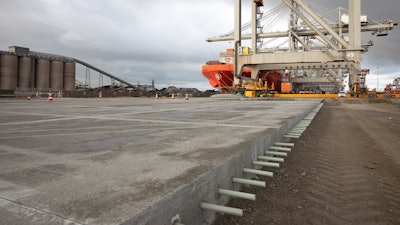High-Performance Composites for Eco-Friendly Building
High-Performance Composites for Eco-Friendly Building
Blog Article
Checking Out the Uses and Advantages of Recycled Composites in Modern Industries
The combinations of recycled products with innovative composite innovations presents an appealing opportunity for boosting sustainability, resilience, and cost-efficiency throughout various industries. As markets seek ingenious options to attend to environmental concerns and enhance operational effectiveness, the consolidation of recycled composites arises as a compelling alternative.
Ecological Advantages of Recycled Compounds
The use of recycled compounds in contemporary industries offers significant environmental benefits, adding to the reduction of waste and the preservation of natural sources. By including recycled composites right into making procedures, markets can lower their reliance on virgin products, consequently lowering the amount of waste generated and the energy required for extraction and manufacturing. This change in the direction of using recycled composites aids in drawing away products from garbage dumps, reducing the problem on waste monitoring systems, and reducing greenhouse gas emissions associated with standard manufacturing methods.
Moreover, using recycled compounds promotes the preservation of natural deposits such as timber, minerals, and water, which are usually diminished with the removal and handling of basic materials (composites). By expanding the life expectancy of materials with recycling, markets can assist protect ecosystems and biodiversity by decreasing the need for brand-new resources. In general, the fostering of recycled composites in contemporary markets plays a crucial function in advertising sustainability and mitigating the ecological impact of manufacturing procedures
Boosted Durability in Product Manufacturing
With an emphasis on long life and effectiveness, including recycled composites into product production procedures enhances durability and sustainability. By utilizing recycled composites, producers can produce products that are not only solid however additionally resistant to deterioration, making them suitable for long-lasting usage in different markets. The combination of different materials in recycled composites can usually result in enhanced stamina and sturdiness contrasted to traditional products, providing a cost-efficient solution for creating resilient items.
Among the key advantages of using recycled compounds in item production is the ability to customize the product residential properties to satisfy specific longevity requirements. By readjusting the structure and manufacturing methods, manufacturers can personalize the recycled compounds to hold up against extreme ecological conditions, hefty loads, or constant usage without jeopardizing on efficiency. This adaptability in style and production enables the development of extremely long lasting items that maintain their stability over time, reducing the demand for constant replacements and eventually adding to a more sustainable production process.
Cost-Effectiveness and Economic Benefits
Including recycled composites into product manufacturing not just improves durability and sustainability but also provides considerable cost-effectiveness and financial benefits. Making use of recycled composites can result in decreased material prices as recycled materials are usually less costly than virgin products. Additionally, recycling composite materials can reduce waste disposal expenses and lower the demand for garbage dump area, adding to overall expense financial savings for industries.

Technology and Design Versatility With Recycled Compounds
Using recycled compounds in modern-day sectors supplies unmatched opportunities for development and style adaptability. By incorporating recycled materials into composite production processes, business can press the borders of traditional layout constraints and check out brand-new possibilities. The adaptability of recycled composites permits the creation of complicated forms and structures that could not be achievable with standard materials.
Among the vital benefits of recycled composites is their ability to be formed right into various basics kinds, offering designers the freedom to experiment with unique sizes and shapes. composites. This adaptability opens a world of imaginative opportunities, making it possible for the advancement of light-weight yet resilient products that fulfill the particular demands of various markets
Moreover, the usage of recycled compounds promotes sustainable practices and sustains the round economy by lowering waste and decreasing the ecological effect of producing procedures. This concentrate on environment-friendly layout remedies lines up with the growing trend towards sustainability in modern-day markets, making recycled composites a beneficial source for ingenious and forward-thinking firms.
Applications Across Different Industries
Recycled composites discover varied and impactful applications across a large range of industries as a result of their unique properties and sustainability advantages. In the automobile market, these products are increasingly made use of for manufacturing sturdy and light-weight parts, boosting fuel efficiency and reducing carbon discharges. The aerospace sector gain from recycled compounds in the production of airplane components, where the materials' strength-to-weight ratio is vital for making certain safety and efficiency. In building, these compounds are used for creating solid yet green structure products, contributing to lasting facilities growth. The sustainable power field utilizes recycled composites in wind turbine blades and photovoltaic panels, utilizing their toughness and resistance to severe continue reading this ecological problems. Additionally, the aquatic industry uses these materials for making watercraft hulls and parts, using improved resilience and corrosion resistance. The convenience and sustainability of recycled compounds make them valuable across different industries, driving development and environmental stewardship. composites.
Conclusion
To conclude, the application of recycled composites in modern-day industries uses significant environmental benefits, boosted longevity in item production, cost-effectiveness, and economic benefits. Moreover, the usage of recycled composites enables innovation and style adaptability throughout various sectors. Overall, the fostering of recycled compounds offers a useful and sustainable remedy for fulfilling the requirements of the industry while also minimizing ecological Our site impact.

One of the vital advantages of utilizing recycled compounds in product manufacturing is the capability to customize the product properties to fulfill certain sturdiness requirements. Making use of recycled composites can lead to lowered product costs as recycled products are typically less expensive than virgin products. The aerospace industry advantages from recycled composites in the manufacturing of aircraft components, where the products' strength-to-weight proportion is critical for ensuring safety and security and performance.
Report this page